+ Open data
Open data
- Basic information
Basic information
| Entry | Database: PDB / ID: 6wm0 | ||||||
|---|---|---|---|---|---|---|---|
| Title | TASK2 in MSP1D1 lipid nanodisc at pH 8.5 | ||||||
 Components Components | Potassium channel TASK2 | ||||||
 Keywords Keywords | TRANSPORT PROTEIN / Potassium ion channel / K2P channel | ||||||
| Function / homology |  Function and homology information Function and homology informationPhase 4 - resting membrane potential / potassium ion export across plasma membrane / regulation of resting membrane potential / outward rectifier potassium channel activity / potassium ion import across plasma membrane / voltage-gated potassium channel activity / potassium channel activity / protein heterodimerization activity / membrane Similarity search - Function | ||||||
| Biological species |  | ||||||
| Method | ELECTRON MICROSCOPY / single particle reconstruction / cryo EM / Resolution: 3.52 Å | ||||||
 Authors Authors | Li, B. / Brohawn, S.G. | ||||||
| Funding support |  United States, 1items United States, 1items
| ||||||
 Citation Citation |  Journal: Nature / Year: 2020 Journal: Nature / Year: 2020Title: Structural basis for pH gating of the two-pore domain K channel TASK2. Authors: Baobin Li / Robert A Rietmeijer / Stephen G Brohawn /  Abstract: TASK2 (also known as KCNK5) channels generate pH-gated leak-type K currents to control cellular electrical excitability. TASK2 is involved in the regulation of breathing by chemosensory neurons of ...TASK2 (also known as KCNK5) channels generate pH-gated leak-type K currents to control cellular electrical excitability. TASK2 is involved in the regulation of breathing by chemosensory neurons of the retrotrapezoid nucleus in the brainstem and pH homeostasis by kidney proximal tubule cells. These roles depend on channel activation by intracellular and extracellular alkalization, but the mechanistic basis for TASK2 gating by pH is unknown. Here we present cryo-electron microscopy structures of Mus musculus TASK2 in lipid nanodiscs in open and closed conformations. We identify two gates, distinct from previously observed K channel gates, controlled by stimuli on either side of the membrane. Intracellular gating involves lysine protonation on inner helices and the formation of a protein seal between the cytoplasm and the channel. Extracellular gating involves arginine protonation on the channel surface and correlated conformational changes that displace the K-selectivity filter to render it nonconductive. These results explain how internal and external protons control intracellular and selectivity filter gates to modulate TASK2 activity. | ||||||
| History |
|
- Structure visualization
Structure visualization
| Movie |
 Movie viewer Movie viewer |
|---|---|
| Structure viewer | Molecule:  Molmil Molmil Jmol/JSmol Jmol/JSmol |
- Downloads & links
Downloads & links
- Download
Download
| PDBx/mmCIF format |  6wm0.cif.gz 6wm0.cif.gz | 105.5 KB | Display |  PDBx/mmCIF format PDBx/mmCIF format |
|---|---|---|---|---|
| PDB format |  pdb6wm0.ent.gz pdb6wm0.ent.gz | 77.8 KB | Display |  PDB format PDB format |
| PDBx/mmJSON format |  6wm0.json.gz 6wm0.json.gz | Tree view |  PDBx/mmJSON format PDBx/mmJSON format | |
| Others |  Other downloads Other downloads |
-Validation report
| Summary document |  6wm0_validation.pdf.gz 6wm0_validation.pdf.gz | 831 KB | Display |  wwPDB validaton report wwPDB validaton report |
|---|---|---|---|---|
| Full document |  6wm0_full_validation.pdf.gz 6wm0_full_validation.pdf.gz | 835.9 KB | Display | |
| Data in XML |  6wm0_validation.xml.gz 6wm0_validation.xml.gz | 20.3 KB | Display | |
| Data in CIF |  6wm0_validation.cif.gz 6wm0_validation.cif.gz | 28.6 KB | Display | |
| Arichive directory |  https://data.pdbj.org/pub/pdb/validation_reports/wm/6wm0 https://data.pdbj.org/pub/pdb/validation_reports/wm/6wm0 ftp://data.pdbj.org/pub/pdb/validation_reports/wm/6wm0 ftp://data.pdbj.org/pub/pdb/validation_reports/wm/6wm0 | HTTPS FTP |
-Related structure data
| Related structure data |  21846MC  6wlvC C: citing same article ( M: map data used to model this data |
|---|---|
| Similar structure data | |
| EM raw data |  EMPIAR-10422 (Title: TASK2 in MSP1D1 lipid nanodisc at pH8.5 / Data size: 2.3 TB EMPIAR-10422 (Title: TASK2 in MSP1D1 lipid nanodisc at pH8.5 / Data size: 2.3 TBData #1: multi-frame micrographs for ion channel TASK2 in open state [micrographs - multiframe]) |
- Links
Links
- Assembly
Assembly
| Deposited unit | 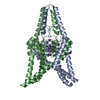
|
|---|---|
| 1 |
|
- Components
Components
| #1: Protein | Mass: 38661.832 Da / Num. of mol.: 2 Source method: isolated from a genetically manipulated source Source: (gene. exp.)   Komagataella pastoris (fungus) / References: UniProt: Q9JK62 Komagataella pastoris (fungus) / References: UniProt: Q9JK62#2: Chemical | ChemComp-K / Has ligand of interest | Y | Has protein modification | Y | |
|---|
-Experimental details
-Experiment
| Experiment | Method: ELECTRON MICROSCOPY |
|---|---|
| EM experiment | Aggregation state: PARTICLE / 3D reconstruction method: single particle reconstruction |
- Sample preparation
Sample preparation
| Component | Name: TASK2 in MSP1D1 lipid nanodisc at pH 8.5 / Type: COMPLEX / Entity ID: #1 / Source: RECOMBINANT | ||||||||||||||||||||
|---|---|---|---|---|---|---|---|---|---|---|---|---|---|---|---|---|---|---|---|---|---|
| Molecular weight | Value: 0.077 MDa / Experimental value: NO | ||||||||||||||||||||
| Source (natural) | Organism:  | ||||||||||||||||||||
| Source (recombinant) | Organism:  Komagataella pastoris (fungus) Komagataella pastoris (fungus) | ||||||||||||||||||||
| Buffer solution | pH: 8.5 / Details: pH at 277K | ||||||||||||||||||||
| Buffer component |
| ||||||||||||||||||||
| Specimen | Conc.: 1.2 mg/ml / Embedding applied: NO / Shadowing applied: NO / Staining applied: NO / Vitrification applied: YES | ||||||||||||||||||||
| Specimen support | Grid material: GOLD / Grid mesh size: 300 divisions/in. / Grid type: Quantifoil R1.2/1.3 | ||||||||||||||||||||
| Vitrification | Instrument: FEI VITROBOT MARK IV / Cryogen name: ETHANE / Humidity: 100 % / Chamber temperature: 277 K Details: 3uL sample, incubate 5 seconds, blot 3 seconds, blot force 1 |
- Electron microscopy imaging
Electron microscopy imaging
| Experimental equipment |  Model: Talos Arctica / Image courtesy: FEI Company |
|---|---|
| Microscopy | Model: FEI TALOS ARCTICA |
| Electron gun | Electron source:  FIELD EMISSION GUN / Accelerating voltage: 200 kV / Illumination mode: FLOOD BEAM FIELD EMISSION GUN / Accelerating voltage: 200 kV / Illumination mode: FLOOD BEAM |
| Electron lens | Mode: BRIGHT FIELD / Nominal defocus max: 2000 nm / Nominal defocus min: 800 nm / Cs: 2.7 mm / C2 aperture diameter: 100 µm / Alignment procedure: COMA FREE |
| Specimen holder | Cryogen: NITROGEN |
| Image recording | Average exposure time: 0.11 sec. / Electron dose: 1.00925 e/Å2 / Film or detector model: GATAN K3 (6k x 4k) / Num. of grids imaged: 1 / Num. of real images: 2814 |
| Image scans | Width: 11520 / Height: 8184 |
- Processing
Processing
| EM software |
| ||||||||||||||||||||||||||||||||||||||||
|---|---|---|---|---|---|---|---|---|---|---|---|---|---|---|---|---|---|---|---|---|---|---|---|---|---|---|---|---|---|---|---|---|---|---|---|---|---|---|---|---|---|
| CTF correction | Type: PHASE FLIPPING AND AMPLITUDE CORRECTION | ||||||||||||||||||||||||||||||||||||||||
| Particle selection | Num. of particles selected: 3806879 | ||||||||||||||||||||||||||||||||||||||||
| Symmetry | Point symmetry: C2 (2 fold cyclic) | ||||||||||||||||||||||||||||||||||||||||
| 3D reconstruction | Resolution: 3.52 Å / Resolution method: FSC 0.143 CUT-OFF / Num. of particles: 78594 / Num. of class averages: 1 / Symmetry type: POINT | ||||||||||||||||||||||||||||||||||||||||
| Atomic model building | B value: 151.61 / Protocol: OTHER / Space: REAL |
 Movie
Movie Controller
Controller




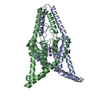
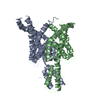
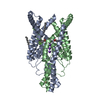
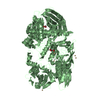
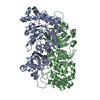
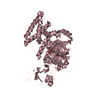
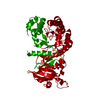
 PDBj
PDBj



